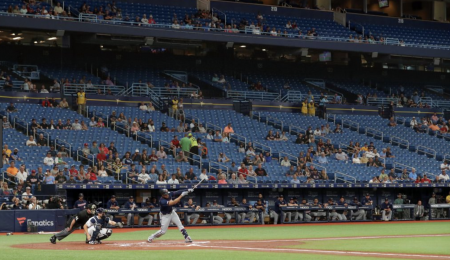Tampa Bay Rays to New York City? Is Three Teams One Too Many?
 Can New York City support three baseball teams?
Can New York City support three baseball teams?
When last we looked, at the end of the 1957 baseball season, just before the Dodgers and Giants headed west, only a mere 62 years ago, three baseball teams cohabited well with each other in New York City. Even though fans of each team fervently rooted for their teams. And did not necessarily enjoy each other’s company.
I knew of one family where the father was a Brooklyn fan, the mother was a New York Giants fan, the oldest son was a Yankees fan, the middle son rooted for the Dodgers and the youngest son loved the Giants. Needless to say, discussions of baseball at the dinner table led to heated discussions that sometimes resulted in grudges that lasted days. There were even fisticuffs between the brothers once. Baseball remains serious stuff to this day, where the division is between the Mets and the Yankees.
On the field, such fervent competition brought out the best in each team. The Yankees, as most everyone knows, won the World Series in 1950, 1951, 1952, 1953, 1956, 1958. They lost the Series in 1955 and 1957.
The New York Giants won in 1954, and the Brooklyn Dodgers won in 1955.
That was 1950s New York baseball, pretty darn successful. Eight World Series championships in nine years.
The competition actually continued into the early 1960s. The Yankees won the World Series against the San Francisco (New York) Giants in seven games in 1962 and lost in a four game sweep to the Los Angeles (Brooklyn) Dodgers in 1963.
So, even though not every baseball decade was as competitive among the three teams as the 1950s, one way of increasing baseball’s relevancy again is to create more heightened rivalries. And what better way than an intense Yankees, Mets and Brooklyn Dodgers (the new team moniker would be something different) rivalry.
Can NYC Field a Third Team Again?
Admittedly, New York City has been a two-team market for 57 years, ever since the 1962 expansion New York Mets brought National League baseball back to the city.
Some detractors of a third team in New York claim the main factor that would hamper a third team is the repeated success of the Yankees.
The Yankees lost 103 games in 1908 and 102 in 1912. Then, 78 years later, they lost 95 games in 1990. Their last losing season was in 1992 when their record was 76-86. Four short years later, they would win four of the next seven World Series between 1996 and 2002. But why should the Yankees’ success hamstring a competitive organization? Tampa Bay is competing effectively despite the Yankees’ huge advantage in revenues allocated to payroll.
Another idea that a new team would need to convert Yankee fans (more than Mets fans) to be successful is specious. Could enough Mets fans be siphoned off for a third team to find success? Or can they find their own fan base?
What if the team were located at Floyd Bennett Field in southern Brooklyn off Flatbush Avenue and the Belt Parkway? Could that team draw on a new population of fans from the southern tier of New York City and Long Island? Many people who live in the southern regions of New York City are not oriented to Manhattan, northern Queens (where Citi Field is) and the Bronx (where the Yankees play). The question is whether they would attend MLB games closer to home.
If the new team were called the Long Island Sounds or Brooklyn Aviators, something like that, would that brand create a new identity that would appeal to fans tired of the Yankees and Mets?
Or will the fact that the Yankees and Mets each have their own regional sports networks, new stadiums erected in the last decade and their own record of success impact a third team moving here?
Maybe. But what if the team relocating was already established? The Tampa Bay Rays, who become the new Long Island Sounds.
Tampa Bay Rays = Long Island Sounds
The Tampa Bay Rays will have to cough up millions if not billions of dollars to indemnify both the Yankees and Mets for encroaching on their 75 mile radius of control. Such a move would also require the approval of a majority of MLB owners.
But if the foundation of the premise—a move from a soft revenue base will generate more revenue—then most owners would be on board with that. Since money is what powers the game.
The Tampa Bay Rays have drawn 842, 518 fans so far this season over 54 home dates. That’s an average of 15,602 fans per game. Or the 29th worst home attendance record. Only the Miami Marlins attendance figures are worse.
In contrast, as bad as the Mets are playing, they’ve drawn the 13th most fans to their games. That’s 1,478,864 over 48 games. That averages out to 30,809 per game. Twice as many people per game as Tampa Bay. And unlike the Mets, Tampa Bay plays inspired, creative baseball games which has them in the thick of the AL East race.
The Yankees are a different breed. They are third in MLB attendance over 53 home dates. They have drawn 2,174,093 for an average of 41,020 per game. That’s almost three times as many fans per game than Tampa Bay.
If the Tampa Bay Rays could draw Mets’ like attendance figures playing in the American League East, they would benefit from the nine home games each against the Yankees and Red Sox. That’s high interest, passionate, emotional baseball games. A lot of fans. And a lot of revenue.
Why Hasn’t This Happened?
Inertia. Lack of vision. And an incorrigible unwillingness to improve the game lest it cause the Yankees and Mets the slightest inconvenience should the Steinbrenners or Wilpons earn a few millions less in the beginning of this experiment.
The other problem is baseball moves at a glacial pace (just like its games) and its pig-headed obstinacy prevents inspired solutions from being readily adopted. Thank goodness for that, sometimes. One of the current ideas being floated, moving the mound back two feet, is ghastly.
But this idea is not ghastly. It’s simple. Move an already successful team out of a dead-end space into a vibrant demographic that loves baseball, has supported three teams in the past, and offers plenty of real estate for a new stadium, new fans and new, exciting rivalries. Add to that a chance to showcase baseball in a new stadium and popularize new baseball stars like Austin Meadows, Tommy Pham, Blake Snell, Tyler Glasnow,and others still coming out of the Tampa Bay Rays solid farm system, and MLB may find itself with more success than it can manage.
Probably too much for MLB to consider at one time.

























